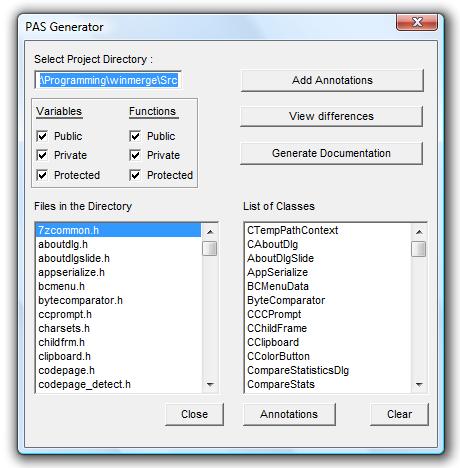PAS
About PAS
 The PAS (Partitioned Annotations of Software) tool is a software application that support the creation and management
of documentation via partitioned annotations. PAS records a programmer's comprehension of a particular component of
a program and makes it available to the programming team as HTML web pages. PAS divides annotations for individual
software components into specialized partitions so programmers can easily associate and find the specific information
they need.
The PAS (Partitioned Annotations of Software) tool is a software application that support the creation and management
of documentation via partitioned annotations. PAS records a programmer's comprehension of a particular component of
a program and makes it available to the programming team as HTML web pages. PAS divides annotations for individual
software components into specialized partitions so programmers can easily associate and find the specific information
they need.
PAS is a stand-alone application that 1) provides programmers a means to document information about a program via
annotations, and 2) parses the program files to construct a collection of partitioned annotations that are exported
to html files. Users are then able to navigate through the program documentation using a standard browser.

PAS is a form of a programmer's notebook in which a programmer can record software understanding without regard for whether
it was aquired in a top-down or bottom-up fashion, whether complete or partial. PAS are based on the existing structure of
the software and do not require any restructuring. Each component of the code (i.e. class, algorithm or function) can have
its own annotation that explains its meaning. These annotations are divided into several partitions, each describing the
component form a different point of view.
PAS distinguishes between between mandatory partitions that are always generated and elective partitions that are generated
on a user's demand. Mandatory partitions include:
- domain and dependencies partitions for the classes
- domain and algorithm partitions for member functions
- domain partitions for arguments
Elective partitions vary from project to project and are based on the project needs. The user supplies the following
information:
- directory of a C++ program to be annotated
- class members to be annotated - for example, public and protected methods
- elective partitions
- the PAS directory to store the PAS=generated documentation
Based on this information, PAS parses the program files and creates skeleton PAS files in HTML format. The files
contain blank spaces for any documentation the user might want to insert PAS relies on the following standards in the
class designing; each class has two files: a header file that also contains all #include statements and a .cpp file
that contains the bodies of the function members. During a change, classes can be deleted or new classes can be
introduced. The next manual step will fill in newly generated skeletons with the fresh in-formation, and correct
obsolete information in the partitions affected by the change. PAS also supports addition or deletion of elective
partitions. If a specific elective partition is deemed obsolete, it can be removed from all PAS files. Similarly,
PAS allows addition of new elective partitions whenever new needs arise in the project.

Compiling and Running PAS
Compiling PAS-Generator
This tool was developed using Microsoft Visual C++ 2007. To compile and run PAS, please follow the next steps:
- Download PAS_Generator_SourceCode_v1.zip.
- Run Microsoft Visual Studio
- Open the Visual Studio solution of HyperOld.sln
- Choose "Build PAS-Generator"
Running PAS-Generator
- To run the program, click "Execute PAS-Generator.exe"
- PAS will start
- Follow PAS's Getting Started to begin the documenting
User manual
Please go to the PAS user manual for the on-line user manual.
Read more
- Rajlich, V., Incremental Redocumentation with Hypertext, in Proceedings of IEEE Euromicro 97, 1997, 68 - 72.
- Rajlich, V., Incremental Redocumentation using the Web, in IEEE Software, 2000.
- Rajlich, V., Varadarajan, S., Using the Web for Software Annotations, International Journal of Software Engineering and Knowledge Engineering, World Scientific Publishing Company, 1999, Vol. 9 No. 1 55 - 72.
- Rostkowycz, A., Rajlich, V., Marcus, A., A Case Study on the Long-Term Effects of Software Redocumentation, Proc. of the 20th IEEE International Conference on Software Maintenance (ICSM'04), 2004.
If you have any questions on the PAS tool, please go to SEVERE Research Group web site for contact information.
 The PAS (Partitioned Annotations of Software) tool is a software application that support the creation and management
of documentation via partitioned annotations. PAS records a programmer's comprehension of a particular component of
a program and makes it available to the programming team as HTML web pages. PAS divides annotations for individual
software components into specialized partitions so programmers can easily associate and find the specific information
they need.
The PAS (Partitioned Annotations of Software) tool is a software application that support the creation and management
of documentation via partitioned annotations. PAS records a programmer's comprehension of a particular component of
a program and makes it available to the programming team as HTML web pages. PAS divides annotations for individual
software components into specialized partitions so programmers can easily associate and find the specific information
they need.
